Cretan food is some of the best anywhere in the world. The combination of traditional recipes and fresh locally grown ingredients results in food that is that rarest of treats: delicious and good for you!
Traditional Cretan food is largely vegetarian, which isn’t surprising on a rocky island with limited grazing but lots of sunshine. Tourist restaurants will server plenty of dishes with meat and fish of course, but even there the quality of the food is mostly down to the freshness of the plant-based ingredients.
Local herbs
Lots of herbs grow wild on Crete and these are generally much richer in flavour that the supermarket varieties found back home. This article is focused on cuisine so I have focused on herbs used in cooking, so herbs like dittany (itself a member of the Origanum family!) aren’t included here. Common edible herbs include…
Oregano (Rigani) and Marjoram
Cretan oregano, known as Rigani, is a little different from the common supermarket variety back home, and is in fact different from oregano often sold as “Greek oregano” too. Oregano and Marjoram are closely related and there are a lot of other species in the genus Origanum, leading to a confusing array of common and formal Latin names. The main genus of Oregano is Origanum vulgare of which there are several sub-varieties including the most common (and blandest) oregano commonly found in the supermarket “Origanum vulgare vulgare”, and true Greek oregano “Origanum vulgare hirtum” (which I believe has good flavour). True Cretan oregano is a different species in the genus, called Origanum Onites which is also sometimes called (incorrectly) “Greek Oregano” or (misleadingly) “Pot Marjoram”.
I have brought some wild Oregano back from Crete that I am confident is Origanum Onites and successfully grown it outdoors in both south Yorkshire and Derbyshire. It is very popular with bees and contributes a great scent to the garden for much of spring and summer. To grow well it likes plenty of sun. It is available online in the UK now, e.g. from Norfolk Seeds, and the RHS have more information about growing it. I have found that it will “root” itself if low lying strands are sat on top of moist compost. The flavour is excellent so I recommend trying it if you can get hold of some.
There is a very nice article describing some of the confusion around oregano and marjoram at SallyBernstein.com and as recommend there I think the ideal is to have more than one variety. Specifically I recommend at least 2 of the following options: Sweet Marjoram (i.e. Origanum majorana); “Italian Marjoram” (Origanum x majoricum) which is a cross between Sweet Marjoram (Origanum majorana) and an Oregano subspecies (Origanum vulgare virens); Greek Oregano (Origanum vulgare hirtum); Cretan oregano (Origanum Onites)
Also note that I believe “Rigani” to refer to the dried flower-heads of Oregano, not to just the leaves and stems. The people in our local village cafe refer to both Oregano and Rigani separately, the Rigani is stronger in scent and flavour!
Sage (Faskomilo)
There are many varieties of sage, with the most common being Salvia officinalis, whilst the sage found in Crete (and much of North Africa) is Salvia fruticosa. This latter sage is the variety most often found in packets of dried sage. I did once manage to bring some wild mountain sage back from Crete and plant it but it was a very young plant and the vigour of the journey was too much for it. I haven’t seen anywhere selling plants in the UK, but seeds are sometimes available on ebay. For more information on the history and usage of Greek sage there is a nice article on Oliveology.co.uk
Thyme (Thymari)
As with so many herbs, the subspecies of Thyme that grows in Crete is different from the one you find in the supermarket back home. The type widely found wild in Crete is Thymus longicaulis, commonly known as Mediterranean creeping thyme), which is available in the UK and is recommended as groundcover and is very popular with bees, but it is not often found listed amongst the best culinary varieties of thyme. The most common culinary thyme is French Thyme (Thymus vulgaris) and other varieties used for culinary purposes include Lemon thyme (Thymus x citriodorus), Oregano-scented thyme (Thymus pulegioides), and Caraway Thyme (Thymus herba-barona). FineGardening.com has a good guide for how to grow thyme successfully
Mint (Menta)
Mint in Crete
Rosemary (Dentrolivano)
Rosemary is another herb with numerous varieties. I haven’t found any in Crete to bring back, so instead I bought 3 different culinary varieties as part of a pack from Rosemaries.co.uk to try growing at home in the UK, all of which have grown well. Most edible varieties of Rosemary are vigorous and upright, whilst Cretan rosemary (rosmarinus officinalis prostratus) is low growing. As the culinary varieties provide excellent flavour I recommend those for cooking, but if you want to attract bees then the Cretan variety makes excellent ground cover and is available online in the UK
Other herbs
Other herbs on Crete are sometimes used in drinks, and you will certainly smell them in the air when driving in the mountains of when tasting Cretan honey. There is a good list with pictures on Creti.co
Popular spices
Crete isn’t the original home to many spices, but as a centre of Mediterranean trade for millennia many spices are well established in Cretan cuisine.
Cinnamon
Cinnamon is used on lots of desserts in Crete, as well as in an alcoholic drink called rakomelo, and in a sweeter version of paximadia (rusks) called paximadia kanelata.
Cloves & nutmeg
Cloves and Nutmeg, like cinnamom, are used in lots of cretan desserts.
Cumin
Cumin is widely used in spice mixes for meats and other savoury dishes, as well as in traditional country bread.
Paprika
Paprika is used in Crete, for example as part of “seasoned salt” which is sprinkled on top of Gryos and other dishes with potatoes or chips. Spicy food is rare in Crete so the paprika found is usually sweet paprika (the scale confusingly goes from “sweet” to spicy, with sweet meaning “not spicy”). I think the traditional paprika is most often Hungarian style (i.e. not smoked), but when cooking at home I tend to use Spanish style (i.e. smoked) sweet paprika as this helps to simulate the smokey flavour from a traditional wood fired oven or grill often used in Crete
Salt & Pepper (black and white)
It would be surprising if salt and pepper weren’t widely used in any cuisine. Cretan food is no different and you will find these two staple flavour enhancing ingredients in many Cretan foods.
Fresh fruit & veg
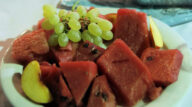 Fresh fruit and vegetables are the most key thing in Cretan food. Tomatoes for example are often large and wonky but have a flavour never found in the UK. Many Cretans have their own parcels of land up in the mountains and mostly use this to grow fruit and nut trees or nearer to the coast for a greenhouse. Melons and Grapes are available in large quanities for pennies, and there are also plenty of other fruits like apples, pears, plums, peaches, nectarines, etc.
Fresh fruit and vegetables are the most key thing in Cretan food. Tomatoes for example are often large and wonky but have a flavour never found in the UK. Many Cretans have their own parcels of land up in the mountains and mostly use this to grow fruit and nut trees or nearer to the coast for a greenhouse. Melons and Grapes are available in large quanities for pennies, and there are also plenty of other fruits like apples, pears, plums, peaches, nectarines, etc.
Olives
Olive trees thrive in the climate and are found in large numbers in Crete with large quantities of olives and olive oil being produced. Local olives are usually small and black and have the stone inside, unlike the large green olives usually sold in the UK. Olive oil is used for almost everything with even things like cakes being made with it, rather than the butter, margarine, etc found in the UK.
Lemons
Lemons are also widely found in Crete, along with oranges (and presumably all other citrus grows well too). They are typically much larger than the ones sold in uk supermarkets and contain more just, but also have thicker skins. When freshly picked they can be used, in front of the air inlet, as wonder air freshener in a car. They are used to enhance the flavour of almost every food served in Crete and I have found them to be magical when adding just a little juice to a Greek Salad.
Tomatoes
The locally produced tomatoes in Crete are large, wonky and absolutely amazing in their flavour, unlike anything you can find in the UK. Sadly in recent years as large western European supermarket chains have slowly taken over (Lidl and Carrefour primarily) they seem to be demanding the same rubbish they serve up to the rest of Europe (bred for even colour, even texture, and to be long lasting, but absolutely zero attention paid to flavour) and so the wonderful local tomatoes are a little harder to find than they once were. A good tomato will be wonky, at least the size of a “beef tomato” back home, and when cut in half will have a central core that is so firm that it is best cut out in a similar way to cutting out the core of an apple. As well as use in all the dishes you would normally use tomatoes in, the Cretans serve them stuffed with a risotto-like mixture, a dish called Gemistas (the first letter is pronounced somewhere between a G and a Y, a phoneme we don’t have in English)
Cucumber
Cucumbers are grown in large quantities locally. For most people they don’t have an especially strong flavour and so they don’t stand out as much as other vegetables do compared to the ones back home, however, with the hot weather they are crunchy, cool, and refreshing which makes them very satisfying.
‘Weeds’ & Spinach
‘Weeds’ in Crete is generally a dish which is made of wild leaves similar to dandelion leaves back home. There are lots of different wild species which are collected and used but all produce a similar result. Back home you can get a similar effect with a mix of leaves from dandelions, spinach, and rocket.
Grape Vine leaves
Grapes are grown everywhere in Crete, for eating, for wine, and for producing Raki. The leaves are also used to wrap a risotto like mixture of flavoured rice and vegetables — the result being known as dolmades. The leaves aren’t used straight from the plant, but instead are wrapped in bunches and then very briefly dipped in boiling salt-water which softens them. If you want to produce your own from scratch Mama’s Taverna has a good guide with pictures.
Bell Peppers
Bell peppers are common in Crete and are grown in the greenhouses. They are used for a number of dishes, including Gemistas and the long sweet pointy peppers are great for simple feta-stuffed peppers. Peppers are also used in many salads even though you don’t see them very often in a “Greek” salad.
Artichokes
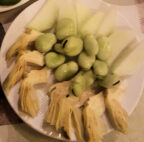 Artichokes are often used in Cretan food, with the hearts often being served raw as mezze. You might also find them roasted or cooked with potato in a Greek-origin stew.
Artichokes are often used in Cretan food, with the hearts often being served raw as mezze. You might also find them roasted or cooked with potato in a Greek-origin stew.
Aubergines & courgettes
Aubergines and courgettes are used to make fritters. In both cases they are shredded, have the moisture squeezed out, and are then mixed with various ingredients including herbs, spices and Cretan cheeses. Aubergines become Melitzano keftedes, and Courgettes become Kolokitho keftedes
Beans & Peas
Large white beans are used in the (in)famous bean soup, which as all Cretans will tell you has the effect that beans are famed for. Broad beans are also widely used, in a range of recipes. There is also a called “Fava” or Favosalata which despite the name is made from yellow split peas not fava beans because “Fava” in Greek translates to “split peas”.
Potatoes
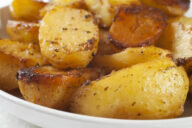 Potatoes are of course originally from South America, but they have been part of Cretan cuisine for as long as anywhere else in Europe. The Cretans like to roast them in the oven with large pieces of meat over the top. These roasted potatoes are typically flavoured with lemon, olive oil, garlic, and herbs. We offer a recipe that should produce authentic tasting results in your oven at home
Potatoes are of course originally from South America, but they have been part of Cretan cuisine for as long as anywhere else in Europe. The Cretans like to roast them in the oven with large pieces of meat over the top. These roasted potatoes are typically flavoured with lemon, olive oil, garlic, and herbs. We offer a recipe that should produce authentic tasting results in your oven at home
Traditional meats
The Cretan landscape offers very little for cows and consequently beef is quite rare in Cretan cuisine. Some of the most popular dishes use pork, but pigs aren’t a very traditional food on Crete either. The main meat source on Crete are the mountain goats and sheep
Lamb / Goat
Crete is home to a unique species of Ibex called “Kri Kri”. These animals are now protected, and more common goats have arrived on the island. As a result much traditional food is based on meat from these types of animals rather than the cows more common in much of mainland Europe and the Americas. Most traditional restaurants will serve “lamb chops” and the well known dish Kleftiko is made with “lamb”.
Pork
 I have never seen a pig on Crete, but that hasn’t stopped Cretans serving plenty of pork dishes. I have wondered if the eating of pork was something the locals did during Ottoman occupation as a way to reject their conquerers, or if it is something that returned after independence. Either way, the Cretans make several dishes very similar to Turkish equivalents, but with pork instead of lamb. The best known are Souvlaki which is a pork version of a shish-kebab, and Gyros which is a pork version of a doner-kebab. I prefer both of them to their lamb equivalent. Souvlaki is much easier to make at home, altho I have successfully made authentic Gyros at home too. Note that Gyros is pronounced to rhyme with “Gear” and “Ross”, not “Eye” and “Rose”!
I have never seen a pig on Crete, but that hasn’t stopped Cretans serving plenty of pork dishes. I have wondered if the eating of pork was something the locals did during Ottoman occupation as a way to reject their conquerers, or if it is something that returned after independence. Either way, the Cretans make several dishes very similar to Turkish equivalents, but with pork instead of lamb. The best known are Souvlaki which is a pork version of a shish-kebab, and Gyros which is a pork version of a doner-kebab. I prefer both of them to their lamb equivalent. Souvlaki is much easier to make at home, altho I have successfully made authentic Gyros at home too. Note that Gyros is pronounced to rhyme with “Gear” and “Ross”, not “Eye” and “Rose”!
Snails
Snails in Crete are fantastic. They are collected from the mountains and then fed on pasta for a couple of weeks to ensure they are “clean”. They are then fried in oil with herbs and garlic. I once tried snails in France and didn’t like them but the way they are cooked in Crete makes them totally different. They are delicious and I can highly recommend them. They come served in their shells and you twist them out with your fork which takes a little bit of practice
Fish and Seafood
Being an island in the middle of the Mediterranean it is no surprise that food from the sea has a significant role in Cretan cuisine. However some of the traditional species are now severely threatened so even if you can find them we would encourage you to stick with species which have healthy populations in the wild. Greece-is.com has a good list for Greece seafood and fish with pictures and the sort of recipes each is found in.
Squid
 Calamari is a very well known Greek food made by battering and deep frying squid. I highly recommend it.
Calamari is a very well known Greek food made by battering and deep frying squid. I highly recommend it.
Octopus
The Cretans serve octopus more often than squid, often grilled or cooked in a sauce. Unlike squid it has a very distinctive flavour.
Red & Grey Mullet
Red mullet is a speciality in Crete and is highly recommended, although as with much fish, it isn’t necessarily the cheapest option. Grey mullet and indeed other varieties can also sometimes be found
Other fish and seafood
 You will find plenty of variety of other fish and seafood in Crete, including: Sea Urchin; Lobster; Hake; Cod; Sea-bream; Shrimps & Prawns; Anchovies, Sardines & Whitebait; Clams & Mussels; Crab; Mackerel; Sea Bass; Bonito; Ray; Grouper; Cuttlefish; Tuna; Swordfish
You will find plenty of variety of other fish and seafood in Crete, including: Sea Urchin; Lobster; Hake; Cod; Sea-bream; Shrimps & Prawns; Anchovies, Sardines & Whitebait; Clams & Mussels; Crab; Mackerel; Sea Bass; Bonito; Ray; Grouper; Cuttlefish; Tuna; Swordfish


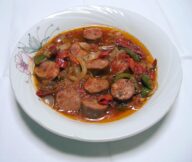

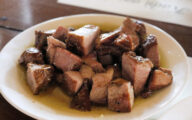
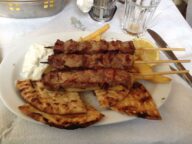
Leave a Reply